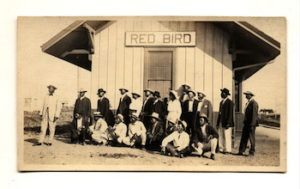
Red Bird, OK. 1907
Black towns in the United States are featured on this date’s Registry. All-Black settlements in the United States have a rich history.
Though residential segregation is often considered one of the more harmful effects of racism in the United States, some Blacks in the nineteenth century chose to form their own racially separate communities. Unlike the ghettos and rural enclaves where many Blacks were forced to live at the time, Black towns were established to promote economic independence, self-government, and social equality for Blacks.
More than 80 such towns were settled 50 years after the American Civil War. This article discusses only a few of these towns.
Some towns, such as New Philadelphia, IL, were formed before the American Civil War. Still, until after Emancipation, the population of free blacks was large enough to supply settlers for the new towns. The first great wave of Black migration came as Reconstruction ended in 1877. After federal troops withdrew from the South, many Blacks feared that their recently acquired civil and political rights would also disappear.
Most Blacks in the South also faced limited educational and economic opportunities. Many responded to the call of Benjamin "Pap" Singleton, a former slave and Underground Railroad "conductor" whose publicity tours and promotional posters helped arouse what historians call the "Kansas Fever" of the late 1870s. Thousands of blacks left their homes and headed for Singleton's Cherokee County colony or Nicodemus in Graham County, Kansas. Nicodemus was founded in 1877 by a corporation of seven members, six black.
Circulars promoting the town as the "Promised Land" were posted throughout the South, and founders hosted visits by potential settlers. By 1879 the town's population stood at about 700. After enduring a decade of harsh weather and bad crops, however, the town's residents were crushed by the 1887 announcement that the Union Pacific Railroad would bypass Nicodemus. Nicodemus soon dwindled and died in a fate shared by the majority of Black towns that failed to attract a rail line.
Founded in 1904, Boley, OK, escaped the trouble that had doomed Nicodemus. Railroad access and arable land helped them, Langston, and at least 20 Black towns in Oklahoma, thrive. By 1907, it had at least 1,000 residents, and twice that many farmers settled outside town. In addition, Boley sang the praises of several businesses, churches, and an industrial school. Booker T. Washington, who played an important role in the success of another black town, Mound Bayou, MS, saw Boley as an example of Black self-help. Its boom soon ended, however, as the Democratic Party gained control in Oklahoma, which achieved statehood in 1907.

With the Jim Crow segregation and discrimination imposition, Boley's population was effectively disenfranchised, and the town was at the mercy of a ruthless state government. Although most towns were founded for the same reasons that white or biracial towns were to exploit natural resources, provide opportunities for settlers, and make money for speculators, black towns shared certain unique characteristics. Black settlers sought not only to find economic and social freedom but to center on ideals of racial uplift.
Established in 1908, Allensworth, CA, California was seen as a "model city," a place to showcase Black respectability, industry, and initiative. In 1917, Robbins, Illinois, was incorporated south of Chicago. Like many black towns, Allensworth's charter prohibited prostitution, gambling, and the sale of alcohol. Such goals, seen as being accommodating, were criticized by some black leaders, such as Ida B. Wells.
Black towns provided a nurturing environment, shielding residents from the everyday racism of white society and offering them opportunities not available in more diverse environments.
To Become An Urban Planner
To become a construction worker.
The Encyclopedia of African American Heritage
by Susan Altman
Copyright 1997, Facts on File, Inc. New York
ISBN 0-8160-3289-0